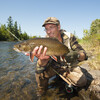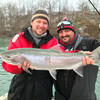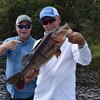
Christmas Walleyes in Summer

The most popular sportfish with resident and non-resident anglers alike—across all of Northern Ontario—is the walleye. And for good reason. Walleyes are found in superb numbers in so many of the tens of thousands of lakes and rivers that dot the Northern Ontario landscape. They're handsome, abundant, relatively easy, and fun to catch using a variety of tactics... and if you keep a few smaller fish to eat, they make for the most incredible shore lunch.

If that wasn't good enough, the news gets even better, because there is a hot technique sweeping across Ontario's walleye wonderland that's taking the fishing world by storm. And I'm betting that if you've never tried it, it will surprise and delight you at the same time.
It is using the very same Rapala Jigging Rap-style lures that I am willing to bet every walleye angler has in his or her winter tackle box. That is right, the same ice jigs that you rely on to catch walleyes in the dead of winter are even better when you show them to the pumped-up fish in July and August.

And if you're flying or driving into a remote outpost camp or five-star resort, nestled amongst the pines and spruce, you don't have to be concerned about babying live minnows, leeches, or nightcrawlers, which have long been the staple baits of choice with walleye hounds.
If there's a secret to presenting the horizontal winter glide baits—my favourites include the original Rapala Jigging Rap, Acme Hyper-Glide, and Freedom Lure Turn Back Shad—it's finding flat, relatively featureless portions of the lake, usually between down as deep as 30 feet deep, that are comprised of relatively snag free sand, small stones, pea-gravel, and mud. If the bottom is blanketed with crisp, skunky-smelling sand grass or chara, you've hit the walleye lottery. And never overlook weedlines, especially the edges of lush beds of red and green cabbage that can be crawling with fat, plump, rotund walleyes.

Because the lures are short, squat, compact, and dense, they sink like stones when you cast them out or troll them behind the boat, making it easy to tame a dastardly wind or heavy current.

I should mention, too, that strolling is without question my favourite way to offer Jigging Rap-style lures to hungry Northern Ontario summer walleyes. I start by casting the lure behind the boat and then adjusting the speed of my Minn-Kota Ultrex trolling motor so that I'm travelling along between about .75 and 1.2 miles an hour. It is a delicate balance because you always want the angle between your rod tip and the lure to be about 45 degrees. This is an important detail because if you cast too far back behind the boat or let out too much additional line, the angle will droop and you'll wind up dragging the lure instead of hopping it.
And erratically skipping it up off the bottom is the key element of the presentation. Indeed, the action that you're trying to achieve is the same walk-the-dog motion you would impart to a topwater stick bait. So, sweep up the lure, but don't tight-line it down when it plummets back to the bottom.

It doesn't have to make contact with the basin on every snap, either, but you do want your lure touching down frequently enough that any following fish can pin it. To develop a steady cadence, and you will soon be whacking walleyes on the same lures that you used to reserve for the winter.
Oh yes, one last critical item.
You will want to spool the reel on your medium action, soft-tipped spinning rod with a quality 10- to 17-pound test dyneema gel spun line like Sufix 832 or Nanobraid. The super line doesn't stretch, so you can feel the slightest bite and set the hook with authority. In fact, it is so non-stretch that I always attach an 18- to 24-inch length of Maxima Ultragreen monofilament to absorb a bit of shock and to buy some insurance.

The soft parabolic rod is also a godsend when you're fighting fish, as walleyes tend to whack the daylights out of Jigging Rap-style lures—it's purely a reflex reaction strike —so they're often hooked lightly around the lips. By keeping the rod bent over and the line under tension, you'll dip so many walleyes into the net this summer that you'll find yourself singing Christmas carols in the summer heat.
Recommended Articles

Do-It-Yourself Fly-In Fishing

Fishing The Shoulder Season

The Amazing Nipigon River

Eagle Lake Island Lodge

Ontario Fly Fishing Hotspots

Ideal Christmas Gifts For The Northern Ontario Ice Angler
Top 8 Places to Ice Fish in Ontario

Long Nose Gar

Top 5 Flies for Smallmouth Bass

Top 5 Tips To Fish Smallmouth Bass in Ontario

Ontario Carp Championship

Eating Northern Pike

Guided Lake Trout Fishing

Fishing Big Rideau Lake

An Angler’s Perspective on Northern Ontario

Ice Shelter Saviours

Top 5 Flies for Brook Trout

Cedar Point Muskies

















